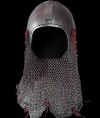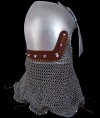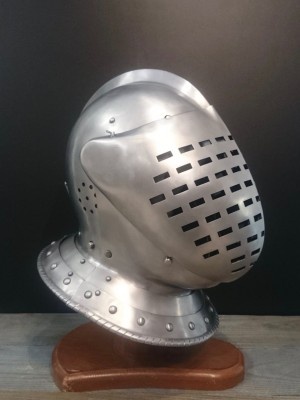Helmet bascinet mid-14th century
AH-10-03
Totale
€580
I costi di spedizione saranno aggiunti al prezzo dell'ordine dopo averlo aggiunto alla carta e aver specificato la tua posizione. Il costo di spedizione dipende dalla regione e dall'articolo ordinato.
Helmet bascinet mid-14th century
Su misura
L’articolo è fatto su misura,il che significa che i nostri artigiani usano le misure individuali del corpo di un cliente per la manifattura. Tale tipo di manifattura fornisce una perfetta calzatura dell’articolo.
Descrizione
Bacinet was a very popular form of helmet dome in the XIV century and often complemented by aventail.
In turn, the nasal plate was a narrow metal plate designed, as you can easily guess, to protect the nose. Helmets with nasal plates were very common in Rus and Western Asia, but in Europe they were superseded by helmets with visors in the XIII-XIV centuries.
Nasal plates were designed to protect the face from not very strong blows, but unlike other means of facial protection, hardly impaired visibility and did not interfere with breathing.
We offer you a helmet with nasal plates of a detachable type (you can read about them here - Helmet's visor fixation types). Such a nasal plate has a hinge which allows it to be folded upwards and it is mounted on a special holder, which allows it to unfast the nasal plate. This is quite a specific type of nasal plate, characteristic only for Western and Central Europe and it was found mainly with bacinets, rarely occurring with cervelliere. Both were designed to be worn under a pot helmet (topfhelm). If desired to improve visibility, the pot helmet was discarded and the knight remained in the bacinet or cervelliere.
A similar nasal plate design was versatile both for helmets where the nasal plate was fixed with the aventail and those where it was not. In the first case you could detach the nasal plate, so that it hangs on the aventail, and in the second case you could flip that nasal plate up.
With the appearance of the visor (you can read about them here - Visors of bascinet: from primitive to grotesque), the klappvisier (originally it looked like a shovel, but later it was pointed - hundsgugel) was mounted on the same fixture. The same helmet could be used with both nasal plate and visor. Usually the visor was fastened for battle, and nasal plate for the tournament, because the tournament traditionally continued to wear not a bacinet with a visor, but an ornate and dignified pot helmet, decorated with heraldic figures, under which was worn a bacinet with nasal plate. It is noteworthy that the word visier originally did not refer to the visor, but to the hinged nasal plate, while the visor (klappvisier) was considered a variation of the nasal plate. With the disappearance of pot helmets disappeared bacinets with such nasal plates, and the word visier began to mean only visor.
Main photo shows authentic battle helm with following options:
- Cold-rolled steel 1.5 mm;
- Satin polishing as finish treatment;
- Black leather for aventail;
- Steel vervelles for aventail;
- Mail aventail;
- Sewn liner
- No decoration
Base price includes following options:
- Cold-rolled steel 1.5 mm;
- Satin polishing;
- Black leather belts;
- Steel nickel-plated buckles;
- Steel rivets;
- Sewn liner;
- No aventail
- No decoration
In options, you may choose another type and thickness of metal, color of belts, finish treatment and decoration.
Benefits, which you’ll get, if you buy medieval helmet at Steel Mastery:
- Custom-made high-quality metal body armor, handcrafted by your individual parameters;
- Reliability and comfortable wearing for years;
- Product made by experienced blacksmiths, who really know how to make a good armor;
- Convenient payment systems (Paypal, Skrill, Visa, MasterCard, American Express);
- Flexible return system in case if you don’t like an item.
You may also like these models of the XIV century bascinets: bascinet with side hinged visor, bascinet helmet without a visor.
In section “Helmets”, you can see all models that we offer for ordering. If you didn’t find any for your taste and wish, please send us photo and description of the required model and we will make it for you.
Se non ti piace il prodotto ricevuto per qualsiasi ragione,puoi mandarlo indietro a noi entro 14 giorni. Se il prodotto ricevuto ha difetti o non calza i tuoi parametri,rifaremo un nuovo articolo e te lo invieremo ai nostri costi. Se il servizio postale ha perso il tuo pacco,facciamo una ricerca. Se il pacco non può essere rintracciato,facciamo un nuovo articolo a nostre spese.
Noi spediamo gli ordini tramite il Servizio Postale Nazionale,che porta gli ordini al tuo ufficio postale locale. Al momento della spedizione,ti forniamo un numero di tracciabilità del pacco. Se hai bisogno della consegna espressa(DHL, TNT, etc…),per favore contattaci
Ogni prodotto è fatto a mano e richiede tempo per la manifattura. Tempo approssimativo:
- Gambeson e armatura imbottita – 8-9 settimane;
- Costumi e altro vestiario – 4-6 settimane;
- Brigandine 3-4 mesi
- Accessori in pelle 2-4 settimane;
- Armatura Metallica 2-5 mesi



















